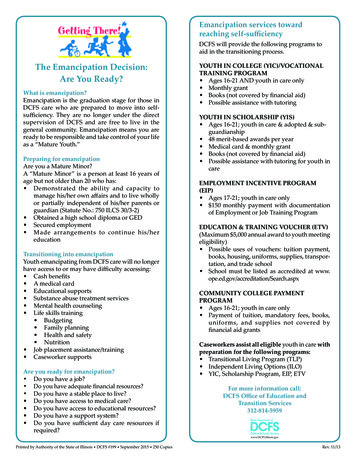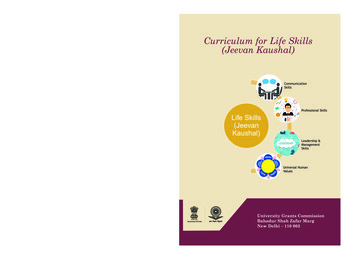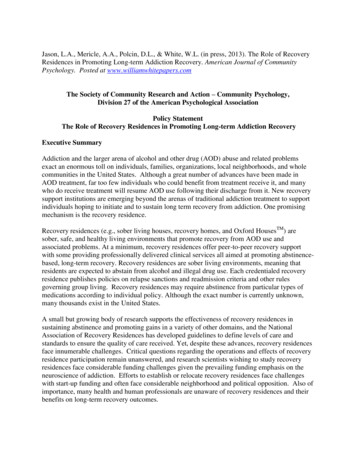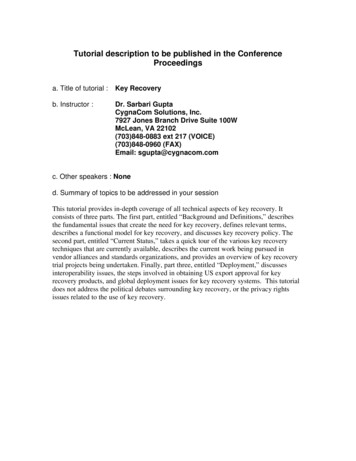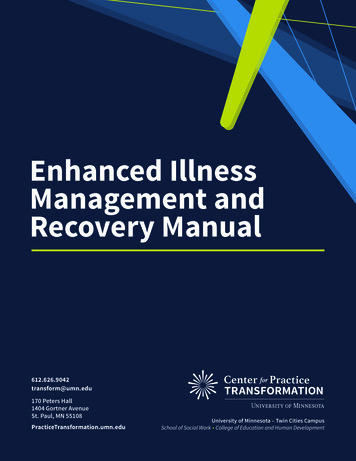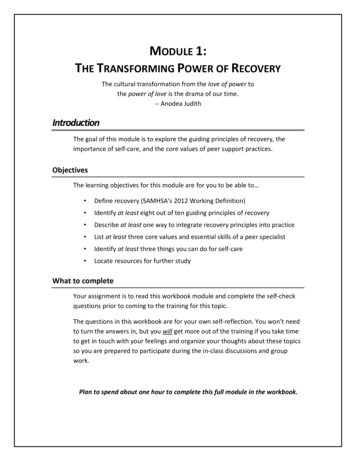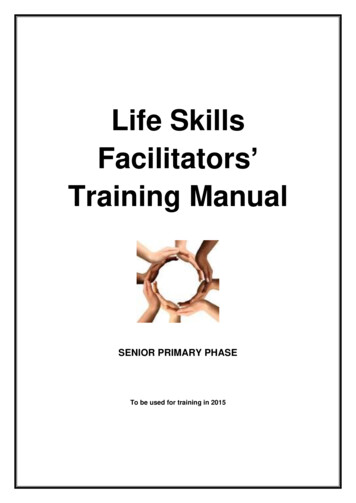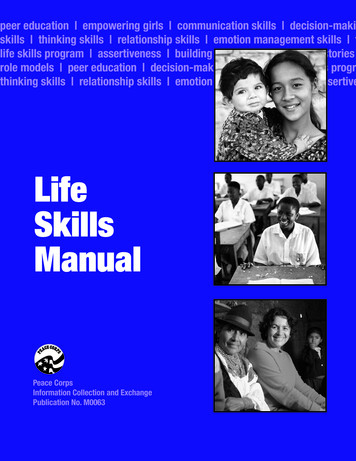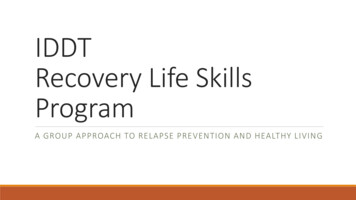
Transcription
IDDTRecovery Life SkillsProgramA GROUP APPROACH TO RELAPSE PREVENTION AND HEALTHY LIVING
ObjectivesProvide an overview of critical issues related toplanning and conducting group interventionsExplore the theoretical framework of Recovery LifeSkills and Integrated Dual Diagnosis Treatment (IDDT)Introduce session outlines for Recovery Life Skillsgroup curriculum
Reflection Questions (Unmute)Some questions to think about:What is your experience with group interventions.How familiar are you with conducting group interventions?What do you like most about conducting groups?What challenges do you have while conducting groups?
FORMAT follows FUNCTIONPsycho-educational: Dissemination of information, didacticSkills-training: Instructional, experientialProcess: Insight oriented, focus on group dynamicsSupport: Mutual responsibility, focus on communityDiagnostic Specific: PTSD, Depression, Anxiety, Substance UseTheoretically-Oriented: DBT, CBT, MI, ACTSetting Specific: inpatient, outpatient, drop-in
The Recovery Life Skills Program nceAbuseCounselingCognitiveBehavioral
The Recovery Life Skills ProgramDuration: Flexible: 18 sessions can be broken up into 36 sessionsFrequency: Flexible: 1-2 sessions/weekSession Length: 60 minutesMembership: open with pre-meetings with new members; closedGroup size: 6-8 membersClient Characteristics: adults, co-occurring, active treatment, relapseprevention
Reflection QuestionsThink of any group you have been a part of (book club, peer support, exercise).What are characteristics of an effective group leader?List behaviors you think are essential for group leadership.What are some signs of a healthy, functioning group?List behaviors you would observe in a healthy, functioning group.
Characteristics of Effective Group LeadersSupports:The development of individual goals in a group settingThe group in developing it’s own identityGroup members in collaborating, sharing, decision-makingProvides:Structure, direction, and guidanceInstruction in a safe, stable learning environmentA model for flexibility, an openness to feedback, and a curiosity for inquiryEmpowers:Group members to take on roles within the groupIndividuals to develop skills
Recovery Life SkillsFacilitators:May be new to Co-occurring DisordersMust be knowledgeable about COD, Substance Abuse Counseling, and peerrecovery support groups.Warm and friendly while able to set healthy, firm boundariesSkilled in group facilitation, motivational interviewing, and social skills trainingAre responsible for communicating with the treatment team on client progressMay choose to co-facilitate for any number of reasons (role-plays, continuity)
Group Member EligibilityProspective Group Members:Co-occurring mental health and substance use disorderActive treatment (not using substances; stable mental health)Relapse PreventionCommitment to sobrietyDesire to learn new skillsSet goals to support lifestyle change****Relapse can be accommodated for once stabilization is achieved andabstinence is committed to.
Pre-Group Interviews
Setting the Stage for Success:Pre-Group Interviews Allows for rapport to be built Clarification of group purpose, format, goals, homework Address questions/concerns Ensure client is in the appropriate stage of treatment for the group Catch client up on Orientation and Goal Identification Address learning/literacy concerns for accommodations Explain policy for relapse-slip and recommit-relapse and refuse to commit-recommit and return-stabilize and return
Goal Setting Activity:Consider a goal you have regarding a lifestyle change.Write down your goal in behavioral terms (observable, measurable,achievable).Write down the steps you are taking or plan to take towards yourgoal.What are some of the small steps you are taking towards your goal?What is one thing you plan to do towards your goal this week?Share with your group members.
Reflection Questions:What did you notice about your commitment to your goalwhen you wrote it down?How about when you shared it with your group members?For those of you actively working on a goal, how have youhandled slips?For those of you planning on working on a goal, what needsto be in place before you can begin the work?
Integrated Dual DiagnosisTreatment for Individualswith Co-Occurring Disorders
Definition of Terms
Co-Occurring Disordersrefers to co-occurring substance use and mental health disorders.Often referred to as COD.Other terms have been used-MICA, MISA, SAMI, ICOPSD, Dual Diagnosis
A Client with Co-occurring Disordershas one or more substance use disorder and one or more mental health disorders.
Diagnosis of Co-occurring Disordersoccurs when the diagnostic criteria for a mental healthdisorder and a substance use disorder are independentlymet and are not simply a cluster of symptoms that resultingfrom only one disorder.Substance induced psychosis is not also schizophrenia.Anxiety resulting from methamphetamine use is not alsopanic disorder.
Reflection Questions as ClinicianConsider your experience working with individuals with cooccurring substance use and mental health issues.What are some of your assumptions about individuals withCOD? (Unmute)What are some of the key issues you have identified asessential for successful treatment and recovery forindividuals with COD? (Unmute)
Prevalence Rates of Co-occurringDisorders1:5 adults with any mental illness also meet criteria for substance usedependence(19.7 percent of all adults with any mental illness)1:4 adults with serious mental illness and substance use dependence(25.7 percent of all adults with serious mental illness)1:2 adults with substance use disorder, (42.8 percent) had co-occurringmental illness2009 NATIONAL SURVEY ON DRUG USE AND HEALTH (NSDUH) ON THE NUMBER OF INDIVIDUALS IN THE UNITED STATES EXPERIENCING CO-OCCURRINGMENTAL AND SUBSTANCE USE DISORDERS.
Historical PerspectiveTreatment has often been separate.Individuals with the most severe mental health and severe substance use disorders were unableto access adequate treatment in either service delivery system.SUD precluded an individual receiving MH treatment.MH treatment needs may have restricted access to some SUD treatment options.
Falling Through the Cracks
Traditional Treatment ModelsSEQUENTIAL TREATMENTPARALLEL TREATMENTLack of clarity around which disorder to treatfirstServices are not integratedUntreated disorder worsens treated disorderUnclear when on disorder is “successfullytreated”Client doesn’t get referred for necessarytreatmentProviders do not communicateBurden of integration falls upon the clientNo one accepts responsibility for the clientLack of common language or methodologyINTEGRATED DUAL DIAGNOSIS TREATMENT, HAZELDEN, 2010 (PG. 12)
Access to TreatmentOf 8.9 million adults with any mental illness and a substance use disorderAccess to TreatmentNo tx40%SUD or MH46%COD14%2009 NATIONAL SURVEY ON DRUG USE AND HEALTH (NSDUH) ON THE NUMBER OF INDIVIDUALS IN THE UNITED STATES EXPERIENCING CO-OCCURRING MENTAL ANDSUBSTANCE USE DISORDERS.
Access to TreatmentSerious Mental Illness and Substance Use DisorderNo Treatment40%Treatment forMH/SUD60%
No Wrong Door
Severity of substance disorderThe Four Quadrants of Behavioral HealthQuadrant III.Less severe mental disorder/moresevere substance disorder.SUD Treatment ProviderResidential, IOP, Outpatient SUD Tx,Medically Managed Detox andMaintenance to Peer RecoveryQuadrant IV.More severe mentaldisorder/more severe substancedisorder.Integrated Co-Occurring CareIncarceration, IDDT,Inpatient Stabilization toAssertive Community TreatmentQuadrant I.Less severe mental disorder/lesssevere substance disorder.Primary CareSBIRT, Prevention, Education,Medication ManagementQuadrant II.More severe mentaldisorder/less severe substancedisorder.Community Mental HealthIntensive OutpatientProgramming to Peer RecoverySeverity of mental health disorderCENTER FOR SUBSTANCE ABUSE AND TREATMENT (CSAT) TREATMENT IMPROVEMENT PROTOCOL, TIP 42
Integrated Treatment
Different Types of Integrated TreatmentOne clinician provides an array of needed services.Two or more clinicians work together to provide needed services.Clinician may consult with specialists and integrate consultation intocare provided.Clinician may coordinate an array of services on an individualtreatment plan that integrates services.One program (PACT) can provide integrated care.Multiple agencies can join together to create a program that serves aspecific population.
Vision of Fully IntegratedTreatment One program treats both disorders One clinician treats both disorders All clinicians trained in psychopathology, assessment, and treatment for both disorders Tailored SUD treatment for SPMI population Treatment is characterized by a slow pace and long-term perspective Stage-wise and motivational counseling is available 12-step groups are available Recovery from both disorders Pharmacotherapies are indicated according to psychiatric and other medical needs.
Individuals with co-occurring disorders are more likely toexperience: Psychiatric episodes Use, abuse, and relapse to alcohol and other drugs Hospitalization and emergency room visits Relationship difficulties Violence Suicide Arrest and incarceration Unemployment Homelessness Poverty Infectious diseases, such as HIV, hepatitis, and sexually transmitted diseases Complications resulting from chronic illnesses such as diabetes and AMI/IDDT
Integrated Dual Diagnosis TreatmentIncreasesReduces Continuity of care Consumer quality-of-life outcomes Relapse of substance abuse andmental illness Stable housing Hospitalization Independent living Arrest Incarceration Duplication of services Service costs Utilization of high-cost /SAMI/IDDT
Integrated Dual DiagnosisTreatmentShared Decision MakingIntegration of ServicesComprehensivenessAssertive Community OutreachReduction of Negative ConsequencesLong-term PerspectiveMotivation-Based TreatmentMultiple Psychotherapeutic InterventionsIDDT MANUAL, DARTMOUTH, PG. 13
Shared Decision MakingClient-centered/family-centered careGoals, treatment course, pathClient, team, support networkHistory, values, preferencesCombine expertise of personal andprofessionalSatisfaction with treatment increases
Integration of ServicesBoth disorders are treated by oneperson or a teamOne treatment plans with sharedresponsibilityOne set of goalsOne relapse planThe key to knowing if care has beensuccessfully integrated .
ComprehensivenessGoal to increase psychosocial supportHousingCase managementSupported employmentFamily psycho-educationSocial skills trainingIllness managementPharmacological treatment
Assertive Community OutreachEngages with clients where they areIncreases accessCommunity case managementHomeless sheltersMobile Crisis Outreach TeamsJail Diversion ProgramsACTProvides for immediate basic needs firstConnects to stabilizing supportsCase load ratio 1:15-30
Reduction of Negative ConsequencesHarm reductionSmall steps before engaging in fullrecoveryAllows client to make progresswithout all or nothing approachIncreases motivation towardsrecovery
Long-term PerspectivePaths to recovery varyThere is no predetermined lengthof timeRecovery is multifacetedNon-linear approachClient driven view point
Motivation-based TreatmentStage of Action-MaintenanceStage of treatment-Engagement-Persuasion-Active Treatment-Relapse Prevention
Multiple Therapeutic Approachesand ConsiderationsInterventions must be individualizedGoals, values, stage of change, stage of treatmentIntensity of needsSeverity and persistenceFunctioning ImpairmentsFamily InvolvementPeer SupportsTraumaCultural DifferencesEmployment, Parenting, Health
Let’s Talk about Recovery
Reflection Questions:What is your definition of recovery? (unmute)What is needed for an individual to achieve recovery? (unmut)How does your definition of recovery inform your work with individualswith chronic, recurring, disabling conditions such as serious and persistentmental illness and/or addictions?
Recovery from SAMHSA’s PerspectiveWorking definition of recovery from mental disorders and/orsubstance use disorders“A process of changethrough which individualsimprove their health andwellness, live a selfdirected life, and strive toreach their full potential.”HealthOvercoming or managing one’s disease(s) or symptoms—for example, abstaining from use of alcohol, illicit drugs,and non-prescribed medications if one has an addictionproblem— and for everyone in recovery, making informed,healthy choices that support physical and emotionalwellbeing.HomeA stable and safe place to livePurposeMeaningful daily activities, such as a job, school,volunteerism, family caretaking, or creative endeavors,and the independence, income and resources toparticipate in societyCommunityRelationships and social networks that provide support,friendship, love, and CDEF/PEP12-RECDEF.PDF
10 Guiding Principles of RecoveryHopeRelationalPerson-DrivenCultureMany Pathways Addresses TraumaHolisticStrengths/ResponsibilityPeer //PEP12-RECDEF/PEP12-RECDEF.PDF
IDDTRecovery Life SkillsProgramA GROUP APPROACH TO RELAPSE PREVENTION AND HEALTHY LIVING
Keys to Session hoiThe shaded text in the session outlines is a script and is asuggestion for what you might say directly to the group. Itis not intended to be read out loud verbatim.This icon indicates when group discussion should occur.When this icon precedes shaded script, it is a reminderthat you are to engage with the group at this point in thesession, addressing them directly and inviting groupinteraction and discussion.This icon reminds you to record important groupcomments and thoughts on the board (blackboard orwhite board). At the end of each session outline, youwill find a reminder to transfer what you have written onthe board onto the Recovery Life Skills Program GroupRecord for Facilitators (available on the CD-ROM or in thethree-ring binder).
5 Step SessionStep 1: Welcome and Check-in: 15 minutesStep 2: Review Previous Session: 10 minutesStep 3: Topic Discussion: 15 minutesStep 4: Personal Recovery Plan Worksheet and Goals: 15 minutesStep 5: Home Assignment: 5 minutes
Step 1: Welcome and Check-in: 15 minutes1. On the board, write the topic for the session and the names of the facilitators.2. Write the affirmation, the check-in questions, and the group guidelines, or display the posterboard that contains this information already written.“I can’t always choose what happens to me, but I can choose what I do about it.”3. Review the group guidelines that were established during session 1.4. Hand out the Personal Recovery Plan Worksheets and then ask for volunteers to answer thecheck-in questions.5. Review the coping strategy they will use until the next session.6. Record the responses onto your Recovery Life Skills Program Group Record for Facilitators.7. Look over the answers recorded on the board and summarize the common patterns since thelast session.
Step 2: Review Previous Session: 10 minutes1. Ask group members what they remember about the last session’stopic. You may need to remind members of the session title to jogtheir memory. Ask a few open-ended questions regarding theirunderstanding of the topic.2. Review the home assignment from the last session. Take the timeneeded; address any incomplete work to emphasize importance.Record answers to homework on board.3. Ask for a volunteer to share one thing they did on their homeassignment.4. Distribute the handouts for the current session.
Step 3: Topic Discussion: 15 minutes1. Reference the individual session outlines in the facilitator manual for specificinformationand advice on leading the topic discussion. Take the time you need to cover thetopic.2. Each topic in the program has a group member handout linked with it.3. Sometimes you will spend a lot of time on the topic, and other times, you mayspend more time on other elements of the session, such as the review.4. There is no one right way to conduct a session, other than to engage with thegroup and follow their lead.
Step 4: Personal Recovery PlanWorksheet and Goals: 15 minutes1. Ask group members to take out their Personal Recovery Plan Worksheet and their Recovery Life SkillsWorksheet for the session.2. As the facilitator, you will hand out Personal Recovery Plan Worksheets during every session.3. Ask what progress they have made on their goal since you last met. Problem-solve around no progress4. Give members 10 minutes to fill out their worksheets, depending on how you are structuring yoursession.5. After they have finished, ask them to share their answers to your questions on this session’s topic.6. Make a copy of each one and keep them in a separate folder for each group member. Encouragemembers to store the originals in one place (a folder or a three-ring binder work well).
Step 5: Home Assignment: 5 minutes1. Tell members what their home assignment is for the session.2. Encourage group members to get people in their support network involved in their homeassignments as much as possible to support them in their efforts and to help them practice newskills.3. Check in with two group members about the progress they are making on their goals and askwhether they have accomplished any of their short-term goals.4. Ask group members to choose one of their short-term goals to work on untilthe next session.5. Remind members of the satisfaction they’ll receive from crossing one of their short-termgoals off their list, once they have accomplished it.6. Ask the group if there are any questions or comments.
Questions? Comments? Remarks?
1:5 adults with any mental illness also meet criteria for substance use dependence (19.7 percent of all adults with any mental illness) 1:4 adults with serious mental illness and substance use dependence (25.7 percent of all adults with serious mental illness) 1:2 adults with substance use disorder, (42.8

